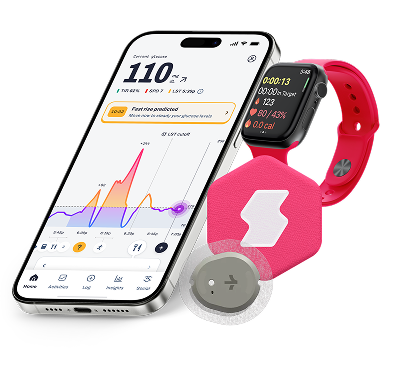Hummus, a popular Middle Eastern spread, is made from chickpeas blended with tahini, olive oil, lemon juice, and spices. This nutritious dish is rich in fiber, protein, and healthy fats, which contribute to its low glycemic index, making it a great option for blood sugar management.¹ ² Additionally, its balance of macronutrients can help promote satiety and support overall health.
This article will explore the glycemic index of hummus and how incorporating it into your diet can offer health benefits.
Sign up to be the first to know about special offers and exciting Signos news.
Glycemic Index Table
Hummus has a Glycemic Index (GI) of approximately 15, which is considered low, meaning it has a minimal impact on blood sugar levels.¹ ² This is due to its high fiber and protein content, which slows the digestion and absorption of carbohydrates. Unlike some carbohydrate-rich foods, the GI of hummus remains stable regardless of preparation method since it does not undergo high-heat cooking that might alter starch structure.
To calculate the Glycemic Load (GL) per 100-gram serving:
GL = (GI * Carbohydrate per serving)
Using the given values:
GL=(15 * 21.4) / 100=3.21
Thus, the GL per 100 grams of hummus is 3.2, which is also considered low.¹ ² Foods with a low GL are excellent choices for managing blood sugar and promoting satiety, making hummus a beneficial option for individuals with diabetes or those aiming to maintain stable energy levels.

Nutritional Facts
Hummus is a nutrient-dense food, offering 321 calories per 100-gram serving. It contains 21.4 grams of carbohydrates, including 7.1 grams of dietary fiber, and 7.14 grams of protein, making it a balanced option for energy and satiety. With 28.6 grams of fat—primarily unsaturated fats—it supports heart health and overall wellness. Additionally, it provides key micronutrients, including 71 mg of calcium for bone health and 1.29 mg of iron, which is essential for oxygen transport. Hummus also includes 8.6 mg of vitamin C, adding antioxidant benefits, though its sodium content of 464 mg should be considered depending on dietary needs.¹ ²
The nutritional information below is for 100g of hummus.
Nutritional Facts

Is Hummus Good for Weight Loss?
Hummus can be an excellent addition to a weight-loss diet, primarily due to its high protein and fiber content, which helps promote satiety and reduces overall calorie consumption. Additionally, hummus is made with nutrient-dense ingredients like chickpeas and tahini, which provide healthy fats and complex carbohydrates, making it a balanced food option.¹ ² It is also free of cholesterol and contains minimal saturated fats, making it a heart-healthy choice for those seeking to lose weight. However, portion control is essential, as hummus is calorie-dense, with about 321 calories per 100 grams.
Is Hummus Good for People Living with Diabetes?
Hummus is a safe and beneficial food for people living with diabetes due to its low glycemic index (approximately 15) and low glycemic load per serving.¹ ² The high fiber and protein content in hummus slow the digestion of carbohydrates, which helps stabilize blood sugar levels after meals. Moreover, its primary ingredients, chickpeas and sesame seeds, are associated with improved insulin sensitivity and reduced postprandial glucose spikes.
Research suggests that the consumption of legumes like chickpeas is linked to a decreased risk of developing type 2 diabetes due to their fiber and resistant starch content.³ Including hummus in a diabetes-friendly diet can provide sustained energy without causing significant blood sugar fluctuations. For best results, pair hummus with non-starchy vegetables such as cucumber, bell peppers, or broccoli.
Better health starts here.
Sign up for tips and insights that work for you!
Allergies
Hummus allergies are often linked to sensitivities to its key ingredients, particularly chickpeas, sesame (found in tahini), or other additives. Allergic reactions to hummus can manifest as oral allergy syndrome (OAS) or food-pollen syndrome, often triggered in individuals with sensitivities to legumes or sesame. Symptoms of OAS may include itchiness or swelling of the mouth, lips, or throat, as well as redness and irritation. In more severe cases, individuals may experience hives, difficulty breathing, or even anaphylaxis. These allergic proteins are primarily found in the chickpeas or sesame used in hummus, but cross-contamination with other allergens during preparation can also occur. If you suspect an allergy, sensitivity, or intolerance to hummus or its ingredients, it is essential to consult a healthcare professional.

References
References
- United States Department of Agriculture FoodData Central. (2024). https://fdc.nal.usda.gov/
- Glycemic Index Foundation. (2024). https://glycemicindex.com/
- National Library of Medicine - PubMed. (2020). https://pubmed.ncbi.nlm.nih.gov/




.svg)
.svg)
.svg)
.svg)
.svg)
.svg)
.svg)
.svg)
